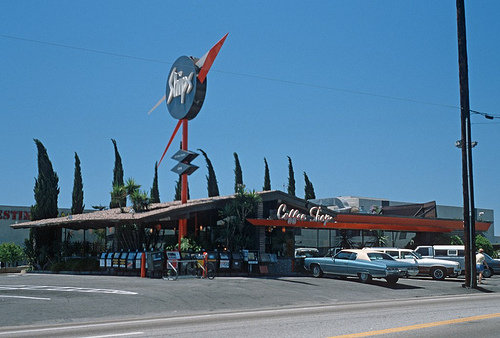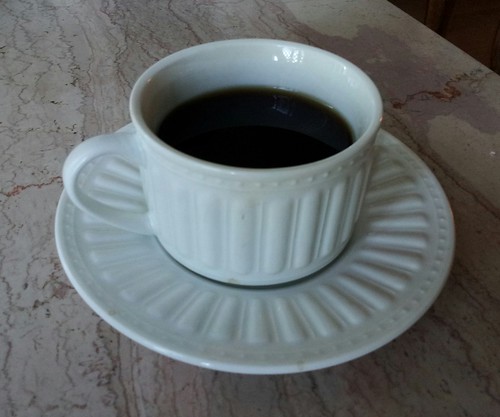Coffee. Java. Joe. Caffeine. Can't live without it, and...well, there we are. When we're sitting in some restaurant and the server advances with the carafe, I usually say "I believe I will have another cup", and my wife is usually thinking, "Jim never has a ninth cup of coffee at home." OK, well, that's an exaggeration, but not by much.
Pardon me while I let my thoughts wander to something important:
Ahh, that was splendid.
Until about twenty-five years ago, "coffee shops", to most Americans, were what we now call casual dining restaurants--or "family style" as they often bill themselves. Despite the fact that these places primarily sold sit-down meals rather than coffee, you were usually welcome to sit in one for hours while ordering nothing but coffee, and that's probably still true in most of these places today. Although many of these places boasted interesting architecture, the interiors were usually quite bland, and had the lights turned up too high and the thermostat too low.
 |
| Former Ship's Restaurant, showing "exhaust vents" |
L.A. was where the Googie style was born and became particularly abundant in the form of coffee shops. For some reason, these places often looked like what you'd get if you went to Hanna-Barbera and told them you wanted something designed by whoever drew The Flintstones and The Jetsons. "And make sure you get the artists from both shows to work on this. I mean it, both shows, or no deal!" The extensive neon signage, plate glass windows, and angled ceilings seemed to reflect from a cartoon-inspired vision of the future. Meanwhile, the lettering in the signs seemed almost primitive by contrast, the way it would have been done in Bedrock. The exterior features of these places, like the "exhaust vents" near
the right hand edge of the picture above, often seemed to be devoid of any structural function whatsoever. For all I know, maybe what we're looking at are hollow pipes running the entire length of the roof, thereby making the roof's structural load lighter. But the point is that they look utterly useless.
On the other hand, much like some of that period's best residential designs, there was an appealingly organic quality to the way the interior and exterior spaces seemed to flow into each other, separated by only the plate glass. The orange-shaded hanging lamps hang on their lines like giant fishing lures, calculated to draw in passersby. They were highly effective at night, or on cool foggy mornings. This was typical of how the best of these Googie-esque restaurants ran counter to the stereotypically bland nature of these establishments.
The fact is, they did more than run counter to it: they snapped their fingers under its nose and dared it to do something about it.
the right hand edge of the picture above, often seemed to be devoid of any structural function whatsoever. For all I know, maybe what we're looking at are hollow pipes running the entire length of the roof, thereby making the roof's structural load lighter. But the point is that they look utterly useless.
On the other hand, much like some of that period's best residential designs, there was an appealingly organic quality to the way the interior and exterior spaces seemed to flow into each other, separated by only the plate glass. The orange-shaded hanging lamps hang on their lines like giant fishing lures, calculated to draw in passersby. They were highly effective at night, or on cool foggy mornings. This was typical of how the best of these Googie-esque restaurants ran counter to the stereotypically bland nature of these establishments.
 |
| Former Ships location, Culver City |
The fact is, they did more than run counter to it: they snapped their fingers under its nose and dared it to do something about it.
By contrast, coffee houses were the hangouts of writers, artists, and musicians, along with others who shared their avant-garde sensibilities. In New York City they were found in Greenwich Village, and L.A. had them in Venice. In San Francisco you could find them in North Beach, and, a few years later, in the Haight-Ashbury. And that's about it. Outside those places there were few if any, with the notable exception of college campuses, where they have always been popular thanks to the typically unstructured nature of student life.
Starbucks began spreading beyond Seattle in the late 1980s, and had reached L.A. by 1991. The company began by selling coffee in higher end grocery stores, alongside museum-like displays that showed off Starbucks coffee beans in various stages of roasting. That same year, L.A.'s first Starbucks coffee shop opened for business at the upscale Beverly Center.
 | |
| Cacao, the first independent coffeehouse in West L.A. Now it's almost the last. |
It would take a few more years before there were Starbucks shops all over town, and the void was filled by independent cafes cropping up, as it sometimes seemed, on every other block. Just about the first of these was Cacao. Occupying the space of a former beauty salon, this pioneering coffee bar aimed for the look and feel of a 1950s coffee hangout. The narrow, cave-like space featured a cement floor and, at the back, a low-to-the-ground postwar Danish style coffee table and chair set, while just behind that was the window through which the very thick 1950s-style ceramic coffee cups, complete with saucers, were passed. Probably around late 1992, the outline of a pistol with angel wings was stenciled onto the cement floor, acknowledging the widespread unease about violent crime which characterized the the city at the time.
 |
| The bamboo counter area, featuring hanging lamps with little flying saucers. And behind it all--Astroboy! |
In 1993 new owners Bobby Green and Alastair Newbery took over, introducing an alien/flying-saucer/science-fiction motif to the interior. However, only a few months later, they remodeled the place in a Polynesian theme, featuring a bamboo counter and other South Seas inspired objects such as cylindrical Tiki-men carved from dark wood.
The flying saucer theme wasn't entirely obliterated. To this day you can find a few reminders inside Cacao. A large toy saucer hangs near the front door to greet entering customers, and spacecraft can be seen on the lamps that hang over the counter.
The bamboo-framed photo with a flying saucer buzzing some tropical city boulevard, visible at the lower left of this shot, has been displayed in the bathroom for nearly twenty years.
The tale of other 1990s coffee houses in the immediate neighborhood is a sad one, because they have all long since disappeared. Java Joe, whose siting in the corner unit of a strip mall, at Brockton and Santa Monica, was highly unpromising at first sight, yet a busy schedule of live music and poetry readings made it a popular neighborhood hangout.
 |
| Brockton Ave. and Santa Monica Blvd., former site of Java Joe |
Java Joe was on the ground level just to the left of the corner. The band House Brew, a brass-heavy ensemble comprising about a half dozen members, packed them in every Sunday night. This band had more types of horns than I knew existed, from small tubas down to what seemed to be a miniature flugelhorn that could be carried in a coat pocket. The sound had a lot of hip-hop to it, and sometimes they invited rappers to stand in front of the band--there was no stage--and do their thing. I couldn't help admire Java Joe's success in establishing and maintaining this vibrant scene.
 |
| Former site of the Two-Part Coffeehouse, between Stoner and Granville on Santa Monica Blvd |
The Two-Part Coffee House was named for its two distinct seating areas, separated by the counter and service area about midway through the cafe. The overall vibe was modernist and calm, with considerably more interior lighting than usual for a coffee house. Not surprisingly, it was popular with local students as a place to study.
 |
| Former site of the Mingle Inn, on Wilshire, west of Brockton Avenue |
 |
| Former site of Lulu's Alibi |
Lulu's Alibi was another popular hangout on Sawtelle, just around the corner from the Nuart Theater on Santa Monica Boulevard. People used to stop in on their way to or from the Nuart Theater, in particular the Rocky Horror Picture Show. At some point in the late 1990s it became Lulu's Blue Plate Restaurant, which probably scared away many of the old customers. When a business calls itself a restaurant--and a "Blue Plate" restaurant at that, you don't feel welcome to sit and while away a couple of hours over coffee. Maybe this was why it didn't last very long after this. Eventually it became a Mediterranean themed restaurant.
 |
| Former site of the Balconi Cafe. Bring on the siphons! (Bing Maps clip) |
The Balconi Cafe, which used to be here where Santa Monica, Rochester, and Centinela meet, has always been famous locally for its siphon coffee. If you've never heard of siphon coffee, click here for a demonstration (YouTube video, which runs a little over two minutes). The Balconi still exists, but some time around 2008 it moved to a boutique mall on the NW corner of Olympic and Sawtelle. Gratifyingly, their space in the mall property is on the ground level and it faces the sidewalk.
 |
| Balconi Cafe exterior. The patches of light are coffee drinkers from the spirit realm. Because it really is that good. |
They do a little show-and-tell after you order, letting you see (and sniff) the freshly ground coffee from which your cup will be brewed.
 |
| Here you see what your cup of coffee is made of. |
And here is what the siphon looks like. At this point, the heat has forced most of the water through the filter and up into the upper vessel, where it has steeped the coffee grounds.
 |
| Coffee brewing siphon with the coffee almost ready to drink |
The barista is about to remove the flame, after which the air in the lower vessel cools and contract, pulling down the freshly brewed coffee, sans grounds. The coffee here costs a buck or two more than a Grande of house brew at Starbucks, but it's worth it.
To be continued.




